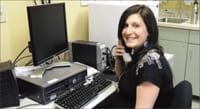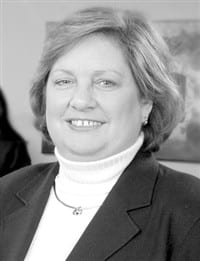Body Of Knowledge Patient Simulator Brings New Educational Opportunities To STCC
His name — on this day, anyway — was Stan.
That’s short for Stan D. Ardman, or “standard man.” He’s a 33-year-old who runs two miles several times a week and is the picture of health.
On other days, however, the new adult human patient simulator at Springfield Technical Community College (STCC) can be John, a 68-year-old truck driver who just suffered cardiac arrest. Or, he can become a she. That’s right — with a few minor but important adjustments to the anatomy, the patient can switch genders, and thus assume one of dozens of new names and patient profiles.
By whatever name it goes, the computer-controlled human patient simulator, or HPS, as it’s known, is changing the face of health education at STCC. Indeed, as he talked about the potential the college’s two simulators have in the classroom, Michael Foss, dean of the School of Health Sciences at STCC, used the term “light years” to describe the level of advancement.
“It’s like night and day, really … as far as the students are concerned, this is real,” said Foss, who told The Healthcare News that the two simulators (one adult and one child) offer learning opportunities simply not possible from a book, a video, or the crude mannequins used at the school for the past several years. “These provide hands-on experience, which is invaluable.”
Manufactured by Florida-based Med-ical Education Technologies Inc. (METI), the simulators are among the latest and most sophisticated simulator products in the market today. They can talk, breathe, react to medications, and, when called for, urinate.
And their talents allow instructors at STCC to turn the school’s new patient simulation area into an emergency room, pediatric care ward, intensive care unit, or cardiac care center, depending on need.
In the process, the college brings almost-real-life experiences to students in several programs at the school, including nursing, medical assistant, respiratory care, patient care associate, and others. Meanwhile, the simulators will an be an asset for the community, presenting innumerable continuing education possibilities for staff of hospitals, nursing homes, and even police and fire departments, said Foss.
“There are a number of opportunities for us to collaborate with area health care providers,” said Foss. “This could become a regional simulation center.”
Shot in the Arm
As The Healthcare News was introduced to the adult simulator, the large, muscular, soft plastic device talked back — sort of.
The voice was that of Foss, who was watching those standing over the simulator from a control room via a video monitor. But to those in the room, the words seemed almost real. When a young student placed a stethoscope over Stan’s chest, he/Foss replied, “where did you get that, out of that refrigerator?”
The dialogue represents one of many ways that the patient simulator takes health education to a new level, said Foss. Mannequins used by the School of Health Sciences — and most colleges and hospitals, for that matter — cannot communicate with the student, he said, adding that this is only one of a number of things that the simulator can do to help students learn.
For example, the HPS can react to more than 40 different medications, and can thus let students know if they’ve administered the right drug in the right dosage. Tiny holes in the simulator’s skin can emit blood or other bodily fluids, giving students additional touches of realism. Meanwhile, the simulators can also be given certain medical conditions, everything from an irregular heartbeat to diabetes, to show students how patients with such problems react to different treatments and medications.
And … the simulator can die, presenting health sciences students with a real-life scenario that can be as traumatic as it is educational (more on that later).
“It’s hard to imagine everything that it can do,” said Foss. “It’s truly a remarkable teaching tool.”
As he demonstrated the system’s software for the The Healthcare News, Foss said that instructors can use the simulators to create a myriad of health conditions and histories. Stan, for example, is healthy in almost every way, he explained, but instructors can tweak his health history to present students with an unlimited number of possible scenarios.
Indeed, the most significant improvement in simulator technology in recent years is the ability of newer models to take away scripted scenarios and introduce the range of possibilities that exists in real life. No two patients are alike, said Foss, and the new simulators reinforce that fact.
The HPS blinks, has a heartbeat and a pulse, and accurately mirrors human responses to such procedures as CPR, intravenous medications, intubation, ventilation, and catheterization. As a result, it provides students with a controlled teaching laboratory, said Foss, where they can practice procedures repeatedly until they become second nature.
To make the learning experience even more real, the college has converted a former academic video studio into a simulated patient-care area. Great lengths have been taken to replicate an actual hospital room, right down to the stuffed animals on the child simulator’s bed to the get-well cards — actually signed by students and faculty members — on Stan’s wall.
Another exciting addition to this working laboratory is a computer-controlled device that simulates intravenous catheterization. Known as a CathSim, the equipment allows students to practice the delicate science of administering intravenous cannulation and intravenous therapy on a variety of patients. In short, the students get to experience the feel of a needle going through the skin and into a vein — without having to practice on actual patients.
Like the HPS, the CathSim gives students the chance to practice under a number of conditions, said Foss. The simulator directs students through six software modules, each one representing a different patient case with varying levels of real-world difficulty and complications. One scenario depicts a 32-year-old man with normal veins, while another replicates a geriatric patient with a history of cardiovascular disease. The student inserts an actual needle into a tactile feedback device that simulates the feeling of the skin and the vein underneath.
Another benefit is that the computer logs the scores of the student conducting practice exercises, said Foss, meaning that faculty members need not supervise the work. “It’s a great learning tool for our students,” he said. “They get to practice needle-stick here, and not on patients.”
Foss told The Healthcare News that he has long desired to bring the high-tech patient simulators to the school, but obtaining the funding has been a four-year-long struggle, one that has been exacerbated by the state’s current budget crisis.
Finally, though a combination of funding sources, the college has been able to obtain the simulators. STCC purchased one computer to control both simulators, he said, adding that he would eventually like to obtain a second computer to allow students to use both devices at once. If possible, he would like to make one of the simulators portable, allowing the school to take it to different health care facilities. Making the device portable would also allow students to learn in the field, at such simulated events as automobile accidents.
“There’s a world of learning possibilities,” said Foss. “The sky is the limit.”
Dose of Reality
METI claims that its HPS is so lifelike, that students have been known to cry when it dies. Foss can believe it.
Soon after the two simulators arrived at STCC, the adult model was hooked up and tested by the manufacturers, he said, and eventually put on a medical course that would end in death. “We knew it was going to happen, and we also knew we couldn’t do anything to stop it,” Foss explained. “And when it did happen, it was traumatic, very real … those feelings of sadness and helplessness swept over us.”
As death came to the simulator, Foss and a faculty member there at the time turned instinctively to a clock in the room to record the time of passing. “That’s how real it was.”
It will be traumatic for students experiencing that same scenario, said Foss, who told The Healthcare News that this is part of learning how to be a health care professional.
In the end, the real function of the HPS is to save lives by making health sciences students and professionals better prepared for the “real thing.” In that respect, Stan, or whomever the simulator becomes on a given day, provides a critical body of knowledge — literally and figuratively.



